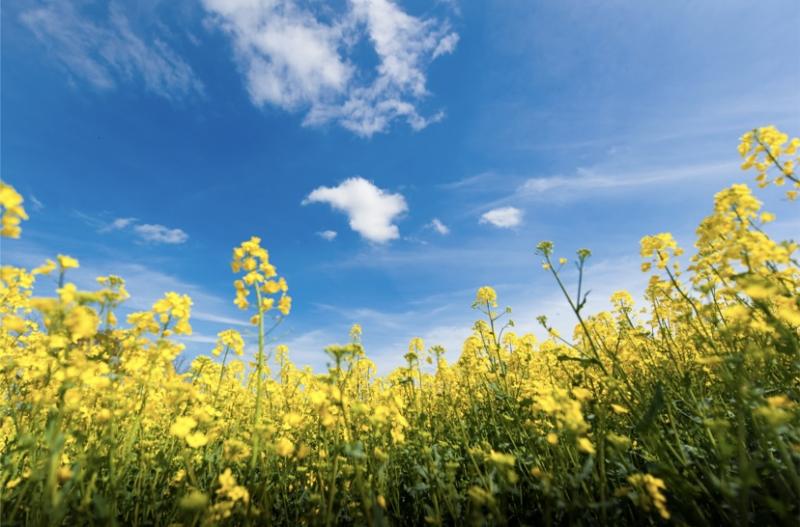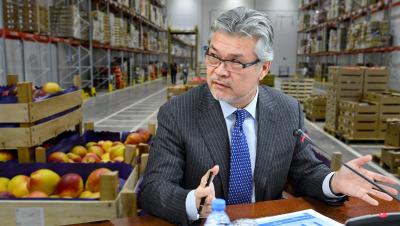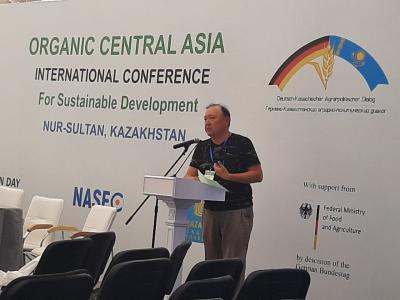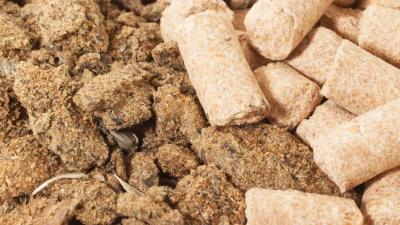
The first months of spring flew by. And if agrarians in some regions of the country have already passed the stage of spring field works and even sowing, the farmers of northern regions are still waiting for warm weather. And this means that farmers of the North have a great opportunity before the sowing season, which is considered the foundation of the new harvest, to get valuable advice on carrying out preparatory work from the leading specialist of agro-management department of "Eurasia Group Kazakhstan" LLP, agronomist Evgeniy Chirkov, a professional with extensive practical experience in agronomy in North Kazakhstan.
Our interlocutor told the World of NAN portal about the crops to bet on for the agrarians in the coming season, what to pay attention to when choosing fertilizers and preventive measures, what technology to choose for successful farming. And the most important - how to prepare the soil and when to start the sowing to get a rich harvest.
Yevgeny Mikhailovich, what crops should farmers of Northern Kazakhstan pay attention to this year, given the approximate weather forecast from weather services for the coming sowing season? What is profitable to sow in the region, given the climatic changes and features of the soil?
Such a long-term forecast may not be proven and farmers are better guided, first of all, by the reserves of moisture accumulated in the autumn-winter period. The last month of winter this year pleased farmers with an abundance of precipitation and moisture reserves in the meter layer of soil, taking into account their residual amount, can be expected in the range of 170-200 mm. Everything depends on the weather in the spring period. If the spring is stormy, some of the water will come off the fields in the form of floods. North-Kazakhstan region is a leader in crop diversification. From 4,2 million hectares of sown area, almost 1 million is sown with oil-bearing crops, price of which is twice higher than the price of wheat. The leader in terms of cultivation area is flax, which is easier to cultivate. In addition to oilseeds, there are pulses, fodder crops and other crops. Crop rotations are mainly formed in farms and they should be maintained.
Tell us about the optimal sowing dates for crops in NKR? Should the farmer rely on his personal experience or take into account the recommendations of experts based on many years of research?
The timing of sowing greatly affects the value of the crop and its quality. In every part of the region scientific departments have developed relevant recommendations based on many years of experience. However, weather conditions often make adjustments. Much depends on the timing and temperature conditions of spring. Average optimum sowing dates for North Kazakhstan are from May 12 to 25, after which it is recommended to sow barley and oats until the fifth day of June. Soil temperatures for seed germination of most cultivated crops fall on these dates as well. To meet these sowing dates, the necessary amount of sowing equipment would be required. Therefore, to extend sowing dates, it is advisable first of all to sow frost-resistant crops such as rapeseed, safflower and others that can withstand short-term frosts down to - 50 C start sowing from May 10. Deviation from the established dates can be varied by 2-3 days in one direction or another, since such factors as the return of cold weather and early August frosts are possible.
Preparation of soils for sowing also affects the volume of productivity. What measures should a farmer take when pre-sowing tillage? What do I have to pay attention to?
Pre-sowing cultivation has the following objectives: weed killing, levelling the surface of the field, creating a seed bed, creating the necessary compaction of the soil for a particular crop. The choice of the tool used depends on this. If the sown crop will be small-seeded, and the small type of weediness prevails, it is necessary to use disc working tools, otherwise - cultivator tines. At zero technology and if the dominant type of weeds is perennial weeds it is necessary to use herbicide pre-sowing treatment. Under the conditions of early spring, when before sowing there are 8-10 days, and the field begins to grow perennial weeds and sprout juvenile weeds, it is necessary to conduct intermediate tillage. Transpiration coefficient of weeds is usually higher than that of cultivated plants and they dry out the sowing layer of soil faster than spring high temperatures. In the North-Kazakhstan region weeds do not reach the sprouting phase by sowing in all zones. The main mass of them, especially minor weeds, is in the phase of "white threads" and some agronomists ignore the process of pre-sowing treatment. After that weeds sprout before the crop and suppress it. To avoid loss of moisture by evaporation, there should not be a time gap between the pre-sowing treatment and sowing. If pre-sowing treatment with herbicides is carried out, then sowing with seeders with cultivator working tools is carried out after 7-10 days so that the active substance of the applied preparation penetrates deep into the root system of perennial weeds. When seeding with disc seeding machines herbicides are applied immediately before sowing or before sprouting.
Availability of moisture is considered as one of the key factors for good yields. Is it necessary to carry out moisture sealing in the spring period in NKR?
The average yield of grain crops in Northern Kazakhstan makes up 12-13 c/ha with the average annual rainfall of 260-350 mm. This suggests that almost half of the soil moisture is lost in the spring and summer period. In early and warm spring evaporation takes up to 50-60 mm, which corresponds to 5-6 c/ha of grain. Therefore, the main task of agricultural producers is not only accumulation of moisture, but also its conservation and rational use. One of the main methods of moisture conservation in the soil is early spring harrowing, which has the following objectives: destruction of capillaries in the soil, due to which moisture quickly evaporates; uniform distribution of crop residues in the field with their partial grinding; embedding of weed seeds in the soil for early germination and destruction in the pre-sowing period. In addition, soil harrowing is aimed at destroying insect larvae hibernating in stubble; cutting large lumps formed as a result of autumn tillage; levelling the soil surface, reducing evaporation and accelerating soil warming, which leads to early growth of weeds. Soil cultivation is carried out by cog, needle and spring harrows to a depth of 4-6 cm. The timing of this procedure should be as short as possible, which means that the units should be wide-cut, productive. In order to avoid over-compaction of wet soil, tractors should be used on crawler or twin wheels. The beginning of harrowing is such a ripeness of soil, when there is no tractor slippage, and the soil structure becomes quite shallow - 3-5 cm. At the early beginning of works the soil will be sticky on the tractor wheels and working elements of the machine. The soil structure will be coarsely cloddy. If the timing is missed, the soil will dry out, which will negatively affect the volume of the crop. In the first place harrowing is carried out on fields where deep tillage was done in the fall, in the second - on shallow cultivated backgrounds. Harrowing of winter crops and perennial grasses is a necessary technique. In late, wet spring, when you can go to the field only a few days before sowing, early spring harrowing is combined with intermediate tillage. The soil is cultivated by steam cultivator or disk harrow.
Evgeniy Mikhaylovich, could you share your recommendations on the choice of fertilizers and means of protection. How to choose, what to pay attention to? How to protect crops from pests and diseases?
At the moment, about 470 names of fertilizers and about 150 products for plant protection are sold in Kazakhstan. The farmer is free to choose what he needs. The question to a greater extent is how to get maximum profit from the use of expensive products? It is no secret that some farms apply fertilizers "blindly", assuming that the soil is low in basic nutrients and that application rates are not justified. As a rule, in such cases, there is no expected return on fertilizer. Fertilizer should be applied in the right amount and to a certain area of the field. For this purpose it is necessary to document the process of harvesting each field with a complete yield map; for each color of the legend of the yield map, which shows areas with the same level of yield, it is necessary to carry out agrochemical analysis of the soil. There will be no more than seven such plots and this will save resources. It is also necessary to analyze the results of field analyses to calculate the rate of fertilizer for each plot of the field for a particular crop. At the same time, fertilizers should be applied differently during sowing, or separately. This approach saves fertilizers and increases the level of yield.
I would like to note that not all farms correctly use the means of plant protection. Usually during the tillering phase of crops fungicides and insecticides are added to the tank mixture of herbicides. In this case, only a part of insects and diseases are treated, even more rarely their number coincides with the threshold of economic harmfulness. To determine the timing of insecticide application, it is advisable to use insect traps that show the increase in the number of pests. Fungicides are applied at reaching the EPI of disease development and spreading, the beginning of which is shown by the weather station with the function of determining the emergence of diseases. Another option for determining the number of pest objects is the use of UAVs equipped with high-resolution cameras, where insects of 0.3 mm in size can be seen. During chemical treatments, Premium class pesticides should be used, containing 2-3 active substances, which increase the spectrum of pest objects to be eliminated. But in the rotation before sowing oil-bearing crops, herbicides containing sulfonylurea must not be used on the preceding crop.
What technologies do North-Kazakhstan agrarians prefer to work with - minimum, zero tillage, conventional technology? Which of them proved to be the most effective? How effectively, in your opinion, is the potential of the region's agricultural land used?
This is probably one of the difficult questions. Much depends on the soil and climatic zone. We need to switch to a zero technology step by step, through a minimum, which may take 5-7 years. But even after this period, you can make sure that it does not suit the farm. In the main territory of the North Kazakhstan region the soils are clayey, heavy. Without deep autumn tillage for a long period of time, "saucers", limans begin to form. One field has to be sown in several stages, due to the different dates of drying of the soil surface, and in autumn, of course, to harvest. On the soils of light granulometric composition of zero technology can be introduced, because it reduces the cost of production within 25-30%, subject to high culture of agriculture in the transition period. But, in my opinion, the most effective technology is the minimum, when the agronomist uses the most justified agricultural practices depending on the weather conditions of the season. For each crop the soil is prepared according to the requirements of the plant, the seeds are sown with a seeder with optimal working bodies, etc. As for the issue of effective use of agricultural land, the answer is unambiguous - the land is used irrationally. Only over the past 4 years 670 thousand hectares of land was withdrawn, which was not used as intended. And this is about 16% of the total sown area of the region! Moreover, there are farmers with small plots of land, who from year to year sow wheat with substandard seeds, violating all cultivation technologies. At the same time getting a yield half as much as the average in the region. Most often, the reason for this is low technical provision of the farm. They do not want to invest finances in agricultural production. What kind of efficiency is there? Meanwhile, the potential for the development of the agricultural sector in North Kazakhstan region is high enough.
Yevgeny Mikhailovich, thank you for the informative conversation!












































Обсуждение